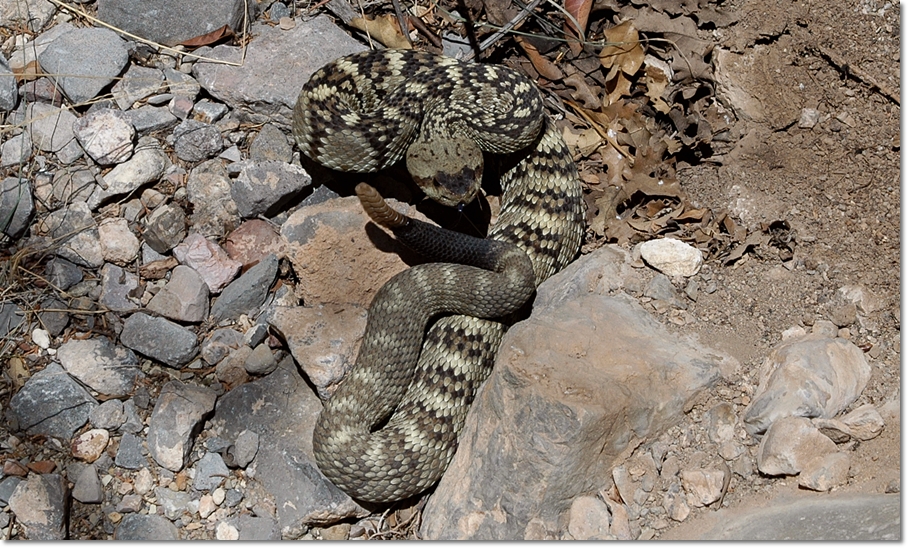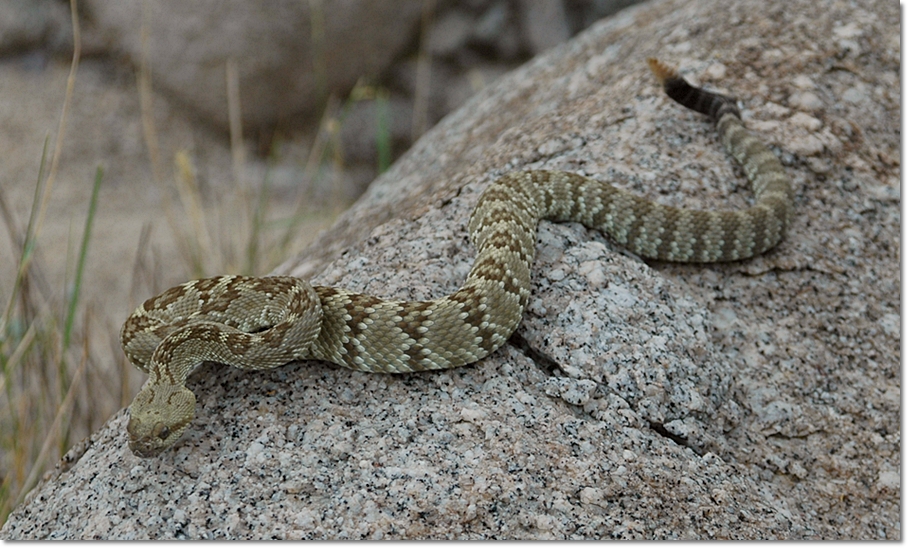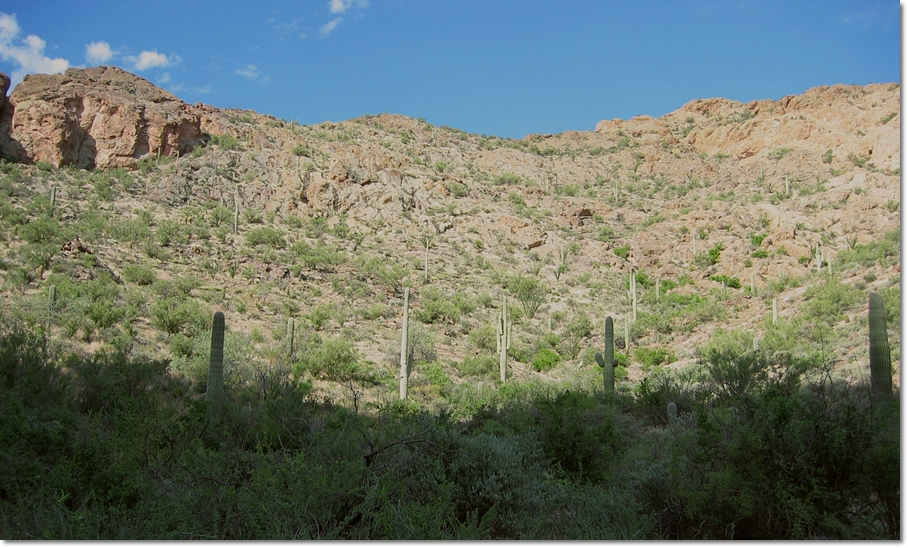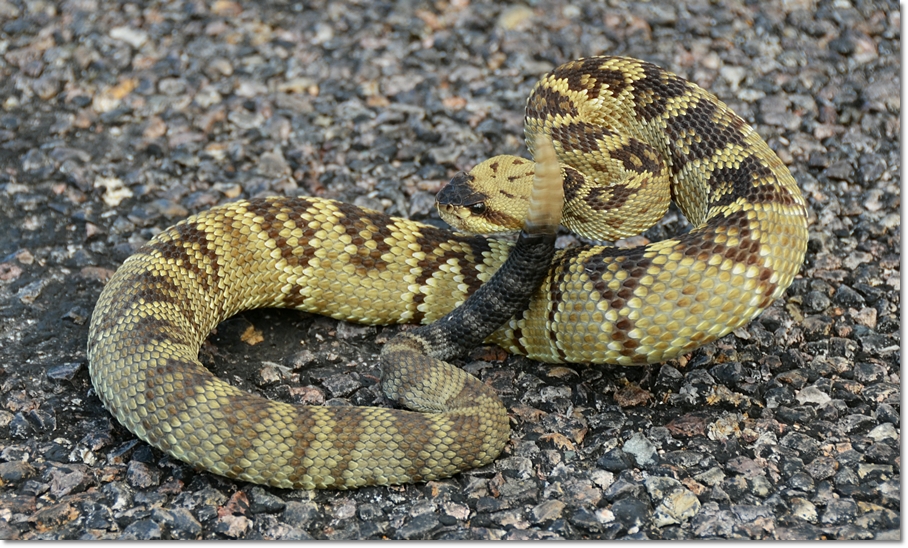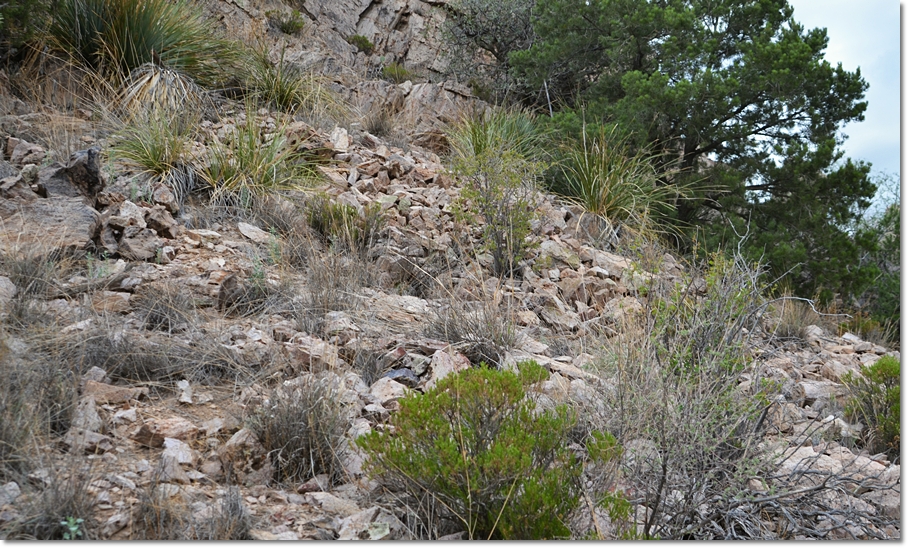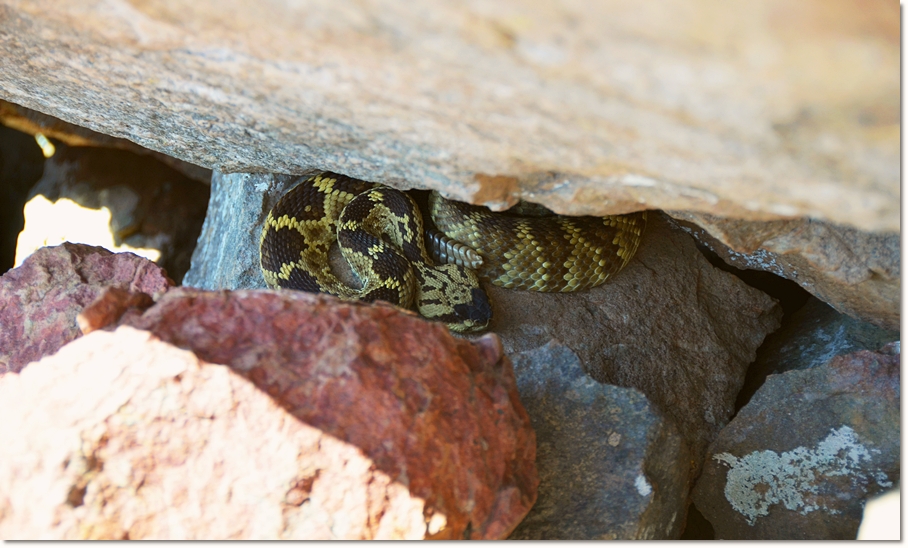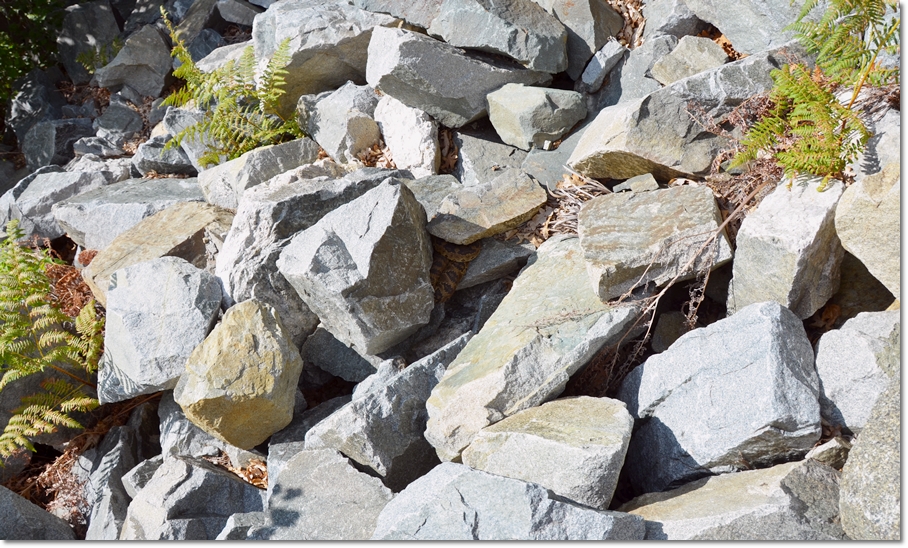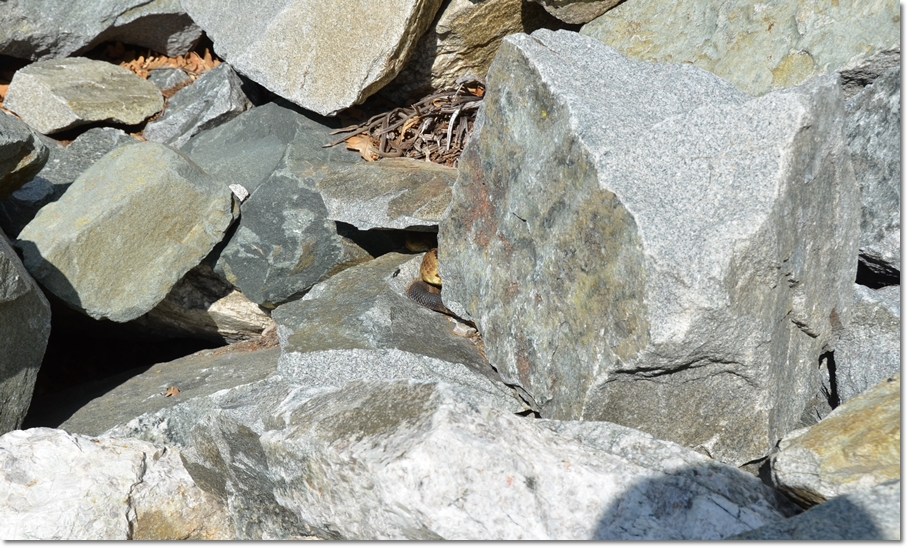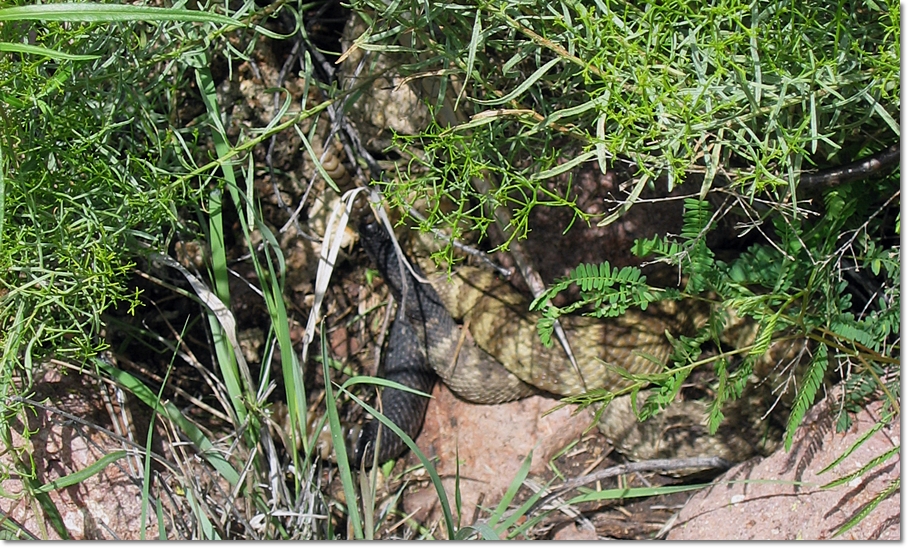
 |
 |
 |
 |
 |
 |
 |
 |
 |
 |
 |
The western blacktail rattlesnake is a medium-sized rattlesnake attaining lengths of up to 52 inches. It is an ecologic generalist inhabiting a variety of habitats throughout its range. This species contains two clades within the United States: the Sonoran Clade and the Madrean Clade1. Phylogenetically, this species is a sister-taxon to Crotalus basiliscus (Mexican West Coast Rattlesnake).
As indicated by its name, the most distinguishing feature of the blacktail rattlesnake is the black tail. Individuals of the nominate species also can exhibit some light gray banding on the tail so that it is not solid black. Another prominant feature of the blacktail rattlesnake is the presence of a dark face mask that covers the top of the snout. From this face mask, a dark stripe runs down through the eyes to the corner of the mouth. Individuals typically have a variety of stripes and dots along the top of the head posterior to the black face mask. The body is thick and adorned with blotches or saddles which run all along the back. The saddles narrow as they progress posteriorly and are usually lighter in color than at the front of the body. Light spots typically are present (especially in Crotalus m. molossus) in the saddles and typically become more prominent posteriorly. Northern blacktail rattlesnake (Crotalus molossus molossus) The nominate species of the western blacktail rattlesnake is often referred to as the northern blacktail rattlesnake (Crotalus molossus molossus). It is found throughout much of Arizona and western New Mexico. The western limits of its distribution is the Colorado River and it occurs in many, if not all, of the mountain ranges throughout its range. To the north its range ends at the Grand Canyon and the Colorado Plateau. At the eastern edge of its distribution, it hybridizes with the eastern blacktail rattlesnake (Crotalus ornatus). Not enough data exists to clearly delineate where this eastern boundary is but it is approximately the Continental Divide that runs north-south through the New Mexico bootheel and Gila Wilderness. Specimens found along this zone show characteristics of both Crotalus molossus molossus and Crotalus ornatus. Where the boundary between the two species lies near the Sonora/Chihuahua border in Mexico. To the south, Crotalus m. molossus occurs in the Sierra Madre Occidental throughout most of Sonora including Isla Tiburón in the Gulf of California. The distrubtion continues eastward to Chihuahua border where it encounters the Mexican blacktail rattlesnake (Crotalus m. nigrescens) to the south and the eastern blacktail rattlesnake Crotalus ornatus) to the north.
Crotalus m. molossus from the lower elevations of the Sonoran Desert typically exhibit a lighter body color with lower contrasting blotches. Body color is most often a shade of tan or light brown. These individuals are often not as large as individuals from the Madrean Clade to the east. Sonoran Clade individuals inhabit dry, rocky mountain ranges which may not get significant amounts of rain each year. The lack of rainfall possibly plays a role in adult size.
Most of these ranges run from the Phoenix area westward and many are less than 6,000 ft. in elevation. Some of the well-known mountain ranges in the Sonoran Clade include the Estrellas, Gila Bends, Harcuvars, Harquahalas, Hualapis, Maricopas, Sierra Madre Occidental, South Mountain, Superstitions, and Tinajas Altas. Some of the snake species found in the same habitat as Crotalus molossus at these lower elevations include: Crotalus pyrrhus, Crotalus tigris, Masticophis bilineatus and Trimorphodon lambda.
Western blacktail rattlesnakes from the Madrean Clade are encountered at the higher elevations of the Sky Islands, Mogollon Rim and Gila Wilderness. They attain a larger size than their low desert counterparts and are also thicker and stockier in appearance. Individuals from these mountainous regions are yellow to brown in color often with higher contrasting blotches. Animals in this region can be found from elevations between 4 - 8,500 ft. Well known ranges in this region include the Animas, Big Hatchets, Chiricahuas, Huachucas, Peloncillos, Pinalenos, and Santa Ritas.
At these higher elevations, Crotalus m. molossus is often associated with rocky outcroppings and talus slides. Large Blacktails are associated generally with boulders and outcroppings or large rock slides with larger-sized rocks usually at least a foot in diameter. Smaller Blacktails are found in talus slides of all rock sizes. During the summer months, this species can be encountered at lower elevations in canyon bottoms and even down in the flats and washes as they disperse for feeding and reproductive activities. Snake species which share habitat with Crotalus molossus in the Sky Islands, Mogollon Rim and Gila Wilderness include: Crotalus cerberus, Crotalus lepidus, Crotalus pricei, Crotalus viridis, Crotalus willardi, Lampropeltis pyromelana and Senticolis triaspis.
Blacktail Rattlesnakes take advantage of the various levels and openings of talus slides to thermoregulate. In the photo below, this snake is sitting exposed in a talus slide but completely in the shade.
But if you just sneak around the rocks a little bit, you will see that part of the snake is actually exposed to the sun and warming the snake up. With the different locations of the gaps and variation in the size of the gaps in the talus slide, blacktail rattlesnakes can control what part(s) of their body they warm up and how much of their body they warm up.
Crotalus molossus feeds on a variety of prey items. Young feed primarily on lizards and small rodents. Larger individuals feed primarily on small mammals ranging from deer mice to squirrels. Birds as well as reptiles may be taken. Crotalus molossus has been documented to have taken a Gila Monster2. The western blacktail rattlesnake can be active year round depending on temperatures with peak activity periods in the summer and early fall months. Crotalus molossus is fond of rainfall and is often active immediately after a heavy monsoon downpour. Breeding is centralized around and after the summer monsoon rains where males will court females. Females retain sperm over winter and young are born the following summer. This species has been documented to copulate in the spring time3 as well although it is unknown how common this is. It is quite possible that Crotalus molossus in the Sonoran Clade exhibit similar breeding cycles as other species found in similar lower, hotter mountain ranges such as Crotalus pyrrhus and Lichanura trivirgata.
Litter size for the western blacktail rattlesnake varies from 2 to 7 young. Females will remain with their newborn young at least until they have their first molting event. Female Crotalus molossus have been known to defend their brood against potential predators. An adult female was observed approaching a potential predator as well preventing her offspring from straying too far from cover4.
Sexual maturity for northern blacktail rattlesnakes occurs typically between 3-5 years of age. Blacktail rattlesnakes do not go through ontogenic color changes as they mature and the maintain their coloration and pattern as they grow although the coloration may intensify or dull a bit with age. Longevity for this species has been documented to be over 20 years in captivity.
1 Anderson, Christopher G. and Eli Greenbaum. 2012. Phylogeography of Northern Populations of the blacktail Rattlesnake (Crotalus molossus Baird And Girard, 1853), With the Revalidation of C. ornatus Hallowell, 1854. Herpetological Monographs 26 (1): 19-57.
2 Funk, Richard S. 1964. On the food of Crotalus m. molossus. Herpetologica 20 (2): 134.
3 Teskey, Aiva, Lily Walsh, Mickey Parker, and Matt Goode. 2015. Crotalus molossus (Black-tailed Rattlesnake). Reproduction. Herpetological Review. 46 (1). 103.
4 Savary, William. 1999. Crotalus molossus molossus (Northern Blacktail Rattlesnake). Brood Defense. Herpetological Review. 30 (1). 45. |
